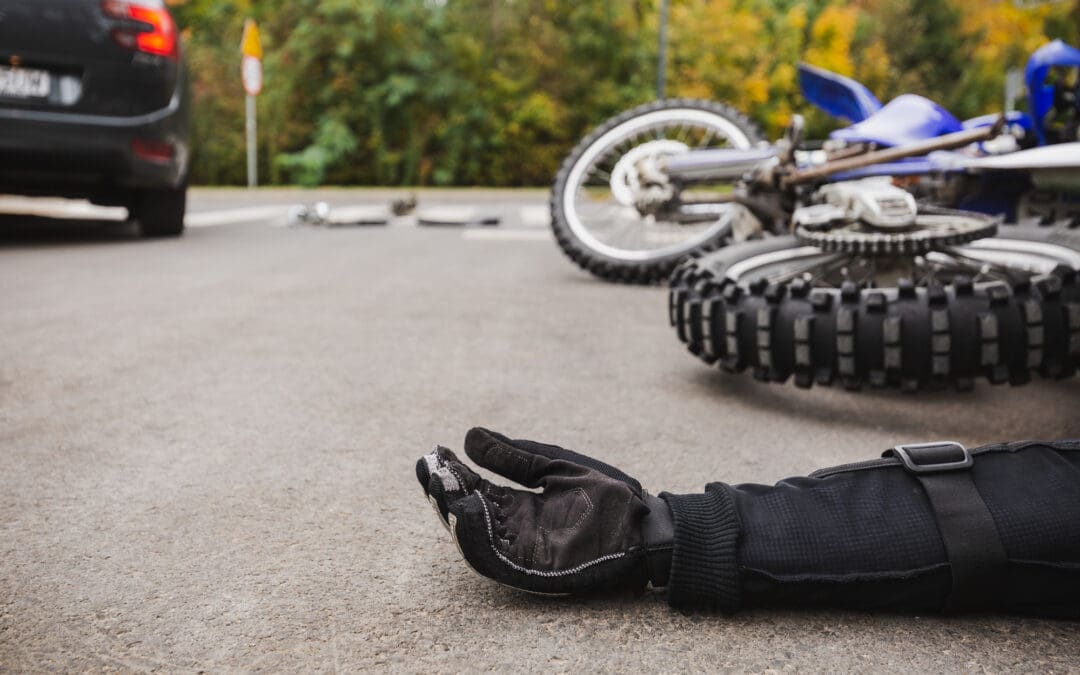Motorcycles are rising in popularity as more people discover the thrill and the efficiency of two small wheels on the open road. With the surge in riders also comes a hike in accidents, however. Both the number of motorcycle crashes and the rate of motorcycle crash fatalities are on the rise, according to the most recent data. The best hope for reducing these numbers is increased education and awareness of motorcycle safety.
Riders can reduce their risk by learning safe motorcycle techniques and becoming familiar with the common causes of motorcycle accidents — as well as the injuries that can happen. Furthermore, all drivers should be aware of the growing number of motorcycles on the road and know how to safely share the highways. Understanding the risks and seeking to minimize them are the first important steps in achieving safer road travel for everyone.
Most Common Causes of Motorcycle Accidents
In addition to safety, understanding the cause of a motorcycle crash is crucial in determining liability for damages and injury when seeking a settlement. How the accident occurs is relevant to determining fault among all of the parties involved, and the allocation of fault can directly impact the value of motorcycle accident settlement.
Here are some common causes of motorcycle crashes according to recent studies of motorcycle accident statistics:
Left-turning Vehicles
One of the most frequent scenarios leading to motorcycle accidents is a car turning left in the path of an oncoming or passing motorcycle. In fact, this is how 42% of fatal motorcycle crashes involving another vehicle occur, according to the National Highway Traffic Safety Administration (NHTSA). This happens because drivers frequently fail to see the motorcycle or fail to judge its speed correctly. Motorcyclists and drivers should be aware of this tendency and always use extra caution when approaching intersections.
High-speed or Aggressive Riding
Aggressive riding behaviors like speeding, weaving in and out of traffic, tailgating, or other reckless maneuvers significantly elevate a rider’s chance of an accident. These actions not only endanger the rider but also other road users, making it a considerable concern for traffic safety. Riders should refrain from these behaviors to avoid becoming liable for damage to life or property.
Rider Inexperience
Novice riders often lack the skills necessary to handle challenging or unpredictable road situations, and this can lead to accidents. Research indicates that riders with only one or two years of experience are about two to four times more likely to crash than more experienced riders. As motorcyclists spend more time learning and practicing, their risk of being involved in accidents diminishes considerably.
Riding Under the Influence
Operating a motorcycle under the influence of alcohol or drugs is a classic recipe for disaster. Impaired judgment, slowed reaction times, and decreased coordination always make an accident far more likely. Recent data from the NHTSA shows that 43% of riders who died in single-vehicle crashes were alcohol-impaired. Motorcyclists can avoid becoming part of this statistic by staying off the bike while under the influence of any substances.
Health Issues
The occurrence of sudden physical problems while riding — such as a heart attack, stroke, or fainting — can cause accidents. These events account for a small percentage of motorcycle crashes. Riders with known health conditions are advised to take extra precautions and consult a doctor about safety concerns before riding.
Mechanical Failure
While motorcycles today are designed with high standards for reliability, mechanical malfunctions can still occur. From brake failures to tire blowouts, such problems are responsible for a certain percentage of motorcycle accidents. Regular maintenance and prompt attention to potential issues will reduce the likelihood of a dangerous mishap.
Weather Conditions
When rain, fog, or snow reduces visibility and makes the pavement slippery, a motorcycle crash may be more likely. Riders should of course use extra caution or stay off the road amid such conditions — and studies suggest that most riders do — because only 3% of motorcycle accidents happen during wet weather. However, the fact that 97% of accidents happen during “good” weather should serve as a reminder to never underestimate the hazards of the road, even when conditions seem to be perfect.
Also, many motorcyclists could be avoiding riding their bikes when the weather isn’t favorable. However, even when conditions are decent, it’s still easy to get into a motorcycle accident because of the dangerous nature of speeding around on two wheels.
Damaged Roadways
Potholes, uneven surfaces, loose gravel, and unmarked obstacles pose significantly greater hazards for motorcycle riders than for most other motorists. With only two wheels and much lighter weight, motorcycles have less traction than trucks and cars. When viewing an upcoming stretch of road, riders should never assume that the safe passage of other vehicles indicates equally safe conditions for their motorcycle.
Dangers Caused by Other Drivers
Distracted or reckless driving by other drivers is an all-too-common cause of motorcycle accidents. The National Safety Council reports that 53% of fatal motorcycle crashes involved two or more vehicles in 2021. Motorcycles are often hard for other drivers to see, and situations where auto drivers follow too closely, change lanes without signaling, or use their phones all exacerbate the risk that a motorcyclist goes unnoticed until it’s too late.
Obstacles Caused by Pedestrians
While less common, pedestrians can unexpectedly step onto the road, creating sudden obstacles for motorcyclists. This risk is highest in densely populated urban areas, where the majority of motorcycle accidents occur. Both riders and pedestrians need to be vigilant, as both can be particularly vulnerable and difficult for drivers to see in crowded roadways.
Lack of Public Education
A lack of awareness and education about motorcycle safety may generally contribute to accidents. Many drivers don’t look carefully for motorcycles before changing lanes or making a turn. Even if they do spot a motorcycle, drivers might misunderstand how to judge its speed or the bike’s relatively short braking distance.
Additionally, many motorcyclists are not adequately trained in defensive driving techniques. Increasing education about how motorcycles operate can reduce accident rates by fostering mutual respect and understanding among all users of the roads.
Common Motorcycle Crash Injuries
Motorcycle riders, given their relative lack of protection compared to automobile occupants, are far more susceptible to injury in the event of an accident. In fact, data show that 80% of motorcycle crashes result in injury or death, compared to just 20% for passenger vehicle crashes.
The type and severity of injuries sustained in a crash can substantially influence the settlement amount in a motorcycle accident case. Compensation often reflects factors like medical expenses, the severity of both physical and mental pain and suffering, along with the potential recovery time and long-term consequences.
Road Rash
Road rash is a common injury in motorcycle accident settlements. This injury is essentially a skin abrasion caused by the friction when a motorcyclist falls and slides across the roadway. Riders can minimize the risk by wearing protective clothing like leather jackets, pants, sturdy boots, and resistant gloves, but no amount of clothing can make a person entirely immune to road rash injury.
Depending on the speed at which the rider was thrown from the bike or the force of the impact, the damage can range from minor to severe. In the worst circumstances, road rash can go past the skin to expose fatty tissue, muscle, or even bone. In some cases, the rider may require painful, expensive skin grafts to repair the wounds, and there is even the possibility of life-threatening infection if not treated properly.
Head and Brain Injuries
Traumatic brain injuries are among the most common causes of death in motorcycle crashes. Other head injuries may include concussions, bone fractures, facial disfigurement, or damage to the eyes. When a crash isn’t fatal, such injuries may still result in long-term pain and suffering, and these damages can significantly increase the amount of compensation in a motorcycle accident settlement.
The single piece of equipment that can reduce the risk of head injury is a motorcycle helmet. The U.S. Centers for Disease Control (CDC) reports that wearing a helmet reduces the risk of head injury by 69% and that helmets are 37% effective in preventing deaths from motorcycle accidents.
Bone Fractures
The force of a collision can easily break bones, with the most common fractures occurring in the arms and hands, legs and feet, and the pelvis. Such injuries might require surgery and lengthy recovery periods. The best way to mitigate this risk is with sturdy protective clothing and riding boots, in addition to wearing a motorcycle helmet.
Leg and Foot Injuries
Because a motorcyclist’s legs and feet are near the ground, they are often the first things to hit the pavement in a crash. The lower extremities can also be crushed by the weight of the motorcycle during the accident. Because of this, leg injuries are very common in motorcycle crashes. Broken bones and torn ligaments are very painful, and the healing process can be lengthy. As a result, leg injury settlements in motorcycle accidents are often larger than leg injury settlements in car accidents.
Spinal Injuries and Paralysis
High-impact crashes or contorted landings can cause a broken back or other injury to the spinal cord resulting in chronic pain, paralysis, or even death. One way to reduce the risk of spinal injury is to wear reinforced back and neck protectors while riding, but severe injuries that require long-term medical care and reduce the victim’s quality of life are still possible.
Chest Injuries
Injuries to the torso can cause many problems that aren’t immediately obvious in the aftermath of a crash. The rib cage protects many vital organs in the body, but a traumatic impact can crack the ribs, cause a collapsed or lacerated lung, and induce internal bleeding. This can lead to difficulty breathing in the short term and severe infections or pneumonia in the long term.
Biker’s Arm
When motorcyclists fall, they often instinctively use their arms to brace or shield themselves, which can lead to a range of injuries including nerve damage. Doctors call it a brachial plexus injury, but this condition is commonly referred to as “biker’s arm” or rider’s arm. The result is loss of feeling or difficulty moving the arm. The nerve injury is sometimes temporary, but it can become a long-lasting effect of a motorcycle accident.
Burns
In a crash, burned skin can result from contact with a motorcycle’s hot components like the exhaust or engine, or may even happen due to explosions and flames. These injuries are not only extremely painful but can cause scarring and require long-term treatment.
Sprains and Muscle Damage
Muscle strains, sprains, or ligament tears can happen during the forceful dynamics of a crash. While not as immediately severe as some other injuries, these damages may have lasting implications for mobility and comfort. Even if they’re minor compared to other potential harm in a crash, muscle injuries can meaningfully influence the amount of a motorcycle accident settlement.
Minimizing the Risk of Motorcycle Accidents and Injuries
Anyone riding a motorcycle must accept the inherent and sometimes unpredictable risks that come with the hobby, but many of these risks can be minimized with riding practice, protective gear, and responsible techniques. It’s also important for riders to understand the risks presented by other motorists, and to understand the concept of liability for accidents and injuries on the roads.
The physical, emotional, and financial consequences of a motorcycle crash can be overwhelming, but if a rider is not completely at fault for the accident, compensation may be available from an accident settlement. By gaining an understanding of all the potential risks, practicing how to minimize them, and knowing where to turn for legal help in the event of an accident, motorcycle riders can enjoy the thrill of the open road with greater peace of mind for safety and well-being.


